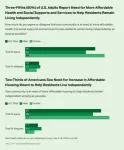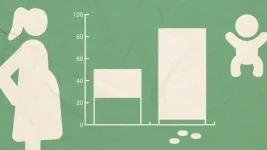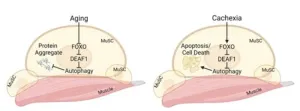(Press-News.org) Rockville, MD ̶ ̶ When a woman becomes pregnant, her iron requirements increase almost tenfold to support fetal development as well as her own increased iron needs. Her ability to meet these increased iron needs depends on her iron stores at the beginning of the pregnancy as well as the physiological adaptations that enhance iron absorption as pregnancy progresses. These physiological adaptations, however, are not always enough to support a pregnant woman’s iron needs, especially among the estimated 50% of women who begin pregnancy with depleted iron stores. While often thought of as a problem in low-resource settings, recent studies have documented iron deficiency rates of 33-42% among pregnant women in high-resource settings.
Iron deficiency can lead to anemia, a condition in which the body can’t produce sufficient hemoglobin, which, in turn, limits the red blood cells’ ability to carry oxygenated blood throughout the body. Anemia during pregnancy is associated with a higher risk of both adverse maternal outcomes and adverse infant outcomes, including postpartum depression, postpartum hemorrhage, preterm birth, low birth weight, and small-for-gestational age birth. Even without the presence of anemia, maternal iron deficiency can result in long-term neurodevelopmental challenges for the child.
At the moment, screening for iron deficiency during pregnancy is not universally routine. Moreover, there is no generally agreed upon diagnostic criteria for iron deficiency during pregnancy. The most recent draft recommendation from the US Preventive Services Task Force, for example, states that “the current evidence is insufficient to assess the balance of benefits and harms of screening for iron deficiency anemia in pregnant women.” In contrast, the International Federation of Gynecology and Obstetrics and European Hematology Society recommend all pregnant women in their first trimester irrespective of the presence or absence of anemia be screened for iron deficiency. Moreover, they also recommend that all women of reproductive age irrespective of the presence or absence of anemia be screened for iron deficiency.
Even when screening is conducted, it may be insufficient to detect iron deficiency. In clinical practice, for example, hemoglobin is frequently the only benchmark used to evaluate iron status among pregnant women. Hemoglobin, however only provides an indication of anemia. As a result, poor maternal and infant health outcomes that may develop before iron deficiency advances to anemia may arise undetected.
Unfortunately, well-designed studies of the changes in iron status during the course of pregnancy are limited. In response, the authors of “Longitudinal Evaluation of Iron Status during Pregnancy: A Prospective Cohort Study in a High-Resource Setting” evaluated the changes in iron biomarkers throughout pregnancy, established the prevalence of iron deficiency, and proposed iron status benchmarks in early pregnancy that predict iron deficiency in the third trimester. The authors, Elaine K. McCarthy et al., also sought to determine how common risk factors for iron deficiency such as obesity and smoking affected iron status throughout pregnancy. The results of the study, one of the largest studies ever to document the changes in iron status during pregnancy, were published in The American Journal of Clinical Nutrition, a publication of the American Society for Nutrition.
To conduct their research, the authors worked with data collected from 641 women in Ireland who were pregnant and had a successful delivery for the first time and who participated in the IMproved PRegnancy Outcomes via Early Detection (IMPROvED) consortium project. Samples were taken from the women at 15 weeks, 20 weeks and 33 weeks of pregnancy to determine iron status. Within 72 hours following delivery, information about the pregnancy, delivery, and the baby were obtained from the mother via an interview with a research midwife. Information pertaining to clinical outcomes and complications during pregnancy and delivery were confirmed by reviewing medical records.
“In this high-resource setting,” the authors found that “iron deficiency defined by a variety of biomarkers and thresholds, was very common during pregnancy, despite the cohort profile as generally healthy.” Interestingly, none of the study participants were anemic in the first trimester, yet more than 80% of the women were iron deficient by the third trimester. In particular, the authors noted that “our cohort had higher rates of deficiency in the third trimester than even some low-resource settings.”
In this study, almost three-quarters of the participants took an iron-containing supplement that contained the Irish/European recommended daily iron allowance of 15-17mg. The authors did note that “iron-containing supplements (mainly multivitamins) taken pre/early pregnancy were associated with a reduced risk of deficiency throughout pregnancy, including the third trimester.”
According to the authors, these findings draw attention to “the benefit of screening for iron deficiency with hemoglobin and ferritin in defined low-risk populations.” Moreover, based on their findings, the authors proposed a threshold for ferritin, a protein that stores iron, of 60µg per liter or less at 15 weeks of pregnancy that predicted the presence of iron deficiency at 33 weeks of pregnancy, defined as 15µg of ferritin per liter or less. The authors noted that “this has previously been identified as the inflection point at which fetal iron accretion is compromised, leading to poorer neurocognitive function and earlier onset of postnatal iron deficiency in the offspring.”
In an accompanying editorial to this study, “Finally, a Quality Prospective Study to Support a Proactive Paradigm in Anemia of Pregnancy,” also published in The American Journal of Clinical Nutrition, authors Michael Auerbach and Helain Landy bluntly labeled the medical community’s approach to women, including the lack of screening and treating iron deficiency and anemia among pregnant women, as “misogyny.” Given the study’s findings, the editorial calls upon the American College of Obstetricians and Gynecologists and the United States Preventive Services Taskforce to “change their approach to diagnosis to screen all pregnant women for iron deficiency, irrespective of the presence or absence of anemia, and recommend supplementation when present for the most frequent nutrient deficiency disorder that we encounter.”
Looking to the future, the authors of “Longitudinal Evaluation of Iron Status during Pregnancy: A Prospective Cohort Study in a High-Resource Setting” believe that “further good-quality, large-scale longitudinal studies of iron status, with concurrent inflammatory status, are needed to provide the evidence base to help establish much-needed consensus. Moreover, the use of early pregnancy iron biomarkers and thresholds should be instituted in better alignment with clinically meaningful health outcomes.”
END
Study finds more than 80% of women iron deficient by third trimester
Study and accompanying editorial published in The American Journal of Clinical Nutrition make strong argument for routine iron screening for all pregnant women
2024-09-26
ELSE PRESS RELEASES FROM THIS DATE:
4 in 5 pregnant women in Ireland are iron deficient by third trimester, study finds
2024-09-26
Four out of five pregnant women in Ireland are iron deficient by their third trimester, a University College Cork (UCC) study reveals. Researchers at the Irish Centre for Maternal and Child Health (INFANT) and School of Food and Nutritional Sciences in UCC have shown that over 80% of women are iron deficient by their third trimester.
The findings raise concerns as the participants in the study were a low-risk and generally healthy cohort. Iron deficiency during pregnancy is linked to increased risks of complications for both mother and child, including neurodevelopmental challenges for the baby.
This study is the largest of its kind globally and was ...
Researchers identify antibodies against Klebsiella pneumoniae
2024-09-26
Research at UMC Utrecht has identified 29 novel antibodies against the bacterium Klebsiella pneumoniae, an important cause of drug-resistant infections. Using genetic and functional approaches, the researchers also managed to unravel how these antibodies interact with antigens on the bacterial surface. Finally, they found that some of these novel antibodies act synergistically to neutralize this pathogen.
The increasing problem of antimicrobial resistance (AMR) urgently calls for the development of alternative ...
Housing, healthcare and social services top list of community needs as U.S. population ages
2024-09-26
WASHINGTON, D.C. — Sept. 26, 2024 — Most Americans agree their community is in need of more affordable housing, healthcare and social supports and services to help residents remain living independently as they age, according to a new survey from West Health and Gallup. Sixty-five percent of Americans perceive a need for more affordable housing and 60% say there is a need for more affordable healthcare and social supports and services.
The new West Health-Gallup research comes as the ...
Mysterious orca group near Chile tracked down, revealing newly discovered hunting skills
2024-09-26
Off the coast of Chile, in waters filled with krill and anchovy by the Humboldt Current system, live an elusive and little-known population of orcas. Thanks to citizen science and years of dedicated surveillance, a team of scientists led by Dr Ana García Cegarra of the Universidad de Antofagasta are unveiling their secrets — starting with dinner.
García Cegarra’s team, who previously observed these orcas using fishing boats to help them capture sea lions, have now spotted them successfully hunting dusky dolphins for the first time and sharing the food among the pod. This new evidence about their eating habits may help experts understand how populations ...
Treatment for major cause of recurrent pregnancy loss
2024-09-26
Amongst women who experience recurrent pregnancy loss, around 20% test positive for a specific antibody that targets the mother’s own body. A Kobe University-led research team now found a treatment that drastically increases these women’s chances of carrying to full-term without complications.
Recurrent pregnancy loss is a condition of women who have lost two or more pregnancies for non-obvious reasons. The Kobe University obstetrician TANIMURA Kenji and his team have previously found that in 20% of these women, they can detect a specific antibody in ...
In an era of climate change, clean water and reliable water storage for floods and droughts is a possibility!
2024-09-26
In recent years, the world has seen a recurrence of extreme floods and droughts due to climate change. In response to this, aquifer storage technology is being used for actual water supply in countries such as the United States, the Netherlands, and Australia. In South Korea, it rains intensively in the summer and extreme rainfall occurs, causing increasing difficulties in water supply in rural areas and island areas other than urban areas. In this situation, aquifer storage technology is attracting attention as a way to stably store and supply water.
Dr. Seongpil Jeong and Kyungjin Cho of the Center for Water Cycle Research at the Korea ...
Risk of buprenorphine triggering sudden opioid withdrawal is low
2024-09-26
Buprenorphine, an evidence-based treatment for opioid use disorder, is currently underprescribed because of concerns that it can cause ‘precipitated withdrawal’, in which the first dose causes sudden, intense pain and anxiety that resolves within a few hours. A new review of the best available evidence has found that the rate of buprenorphine-precipitated withdrawal in adults with opioid use disorder is low and should not be a barrier to use. The review is published in the scientific journal Addiction.
Lead author Dr Caroline Gregory, of the University of Ottawa, explains: “There is a lot of speculation ...
FAIR Health releases interactive tool tracking opioid abuse and dependence state by state
2024-09-26
NEW YORK, NY—September 26, 2024—Today FAIR Health released the Opioid Tracker, a free, interactive tool tracking opioid abuse and dependence state by state. A brief released simultaneously offers a user’s guide to the Opioid Tracker.
Available on FAIR Health’s website fairhealth.org, the Opioid Tracker includes a heat map representing the percentage of patients with opioid abuse and dependence diagnoses compared to all patients receiving medical services in 2023 for each state. Clicking on a state displays an infographic for ...
Duke-NUS discovery advances quest for treatment for age- and cancer-related muscle degeneration
2024-09-26
With the global population ageing rapidly, sarcopenia, a condition that affects millions of older adults and severely diminishes their quality of life, is emerging as an urgent public health issue. Now, a new discovery by scientists at Duke-NUS Medical School could lead to improved treatments for the condition.
In the study, published in the journal Autophagy, the scientists found that the levels of a certain type of protein, called DEAF1 (Deformed epidermal autoregulatory factor-1), need to be maintained within optimal levels ...
Women with premature ovarian insufficiency are at greater risk of severe autoimmune diseases
2024-09-26
Severe autoimmune conditions such Type I diabetes, Addison’s disease, lupus and inflammatory bowel disease, are between two to three times more common in women who have been diagnosed with premature ovarian insufficiency (POI) compared to the general population.
The research, published today (Thursday) in Human Reproduction, one of the world’s leading reproductive medicine journals, is the largest to investigate the link between autoimmune conditions and POI, has followed nearly 20,000 women for ...
LAST 30 PRESS RELEASES:
Scientists trace microplastics in fertilizer from fields to the beach
The Lancet Obstetrics, Gynecology, & Women’s Health: Taking paracetamol during pregnancy does not increase risk of autism, ADHD or intellectual disabilities, confirms new gold-standard evidence review
Taking paracetamol during pregnancy does not increase risk of autism, ADHD or intellectual disabilities
Harm reduction vending machines in New York State expand access to overdose treatment and drug test strips, UB studies confirm
University of Phoenix releases white paper on Credit for Prior Learning as a catalyst for internal mobility and retention
Canada losing track of salmon health as climate and industrial threats mount
Molecular sieve-confined Pt-FeOx catalysts achieve highly efficient reversible hydrogen cycle of methylcyclohexane-toluene
Investment in farm productivity tools key to reducing greenhouse gas
New review highlights electrochemical pathways to recover uranium from wastewater and seawater
Hidden pollutants in shale gas development raise environmental concerns, new review finds
Discarded cigarette butts transformed into high performance energy storage materials
Researchers highlight role of alternative RNA splicing in schizophrenia
NTU Singapore scientists find new way to disarm antibiotic-resistant bacteria and restore healing in chronic wounds
Research suggests nationwide racial bias in media reporting on gun violence
Revealing the cell’s nanocourier at work
Health impacts of nursing home staffing
Public views about opioid overdose and people with opioid use disorder
Age-related changes in sperm DNA may play a role in autism risk
Ambitious model fails to explain near-death experiences, experts say
Multifaceted effects of inward foreign direct investment on new venture creation
Exploring mutations that spontaneously switch on a key brain cell receptor
Two-step genome editing enables the creation of full-length humanized mouse models
Pusan National University researchers develop light-activated tissue adhesive patch for rapid, watertight neurosurgical sealing
Study finds so-called super agers tend to have at least two key genetic advantages
Brain stimulation device cleared for ADHD in the US is overall safe but ineffective
Scientists discover natural ‘brake’ that could stop harmful inflammation
Tougher solid electrolyte advances long-sought lithium metal batteries
Experts provide policy roadmap to reduce dementia risk
New 3D imaging system could address limitations of MRI, CT and ultrasound
First-in-human drug trial lowers high blood fats
[Press-News.org] Study finds more than 80% of women iron deficient by third trimesterStudy and accompanying editorial published in The American Journal of Clinical Nutrition make strong argument for routine iron screening for all pregnant women






